View in other NatureServe Network Field Guides
NatureServe
Montana
Utah
Wyoming
Idaho
Wisconsin
British Columbia
South Carolina
Yukon
California
New York
Montane Vole - Microtus montanus
Native Species
Global Rank:
G5
State Rank:
S5
(see State Rank Reason below)
Agency Status
USFWS:
USFS:
BLM:
External Links
State Rank Reason (see State Rank above)
Common to uncommon across montane and to a limited extent valley habitats. Likely stable with no known threats
General Description
The adult Montane Vole can measure from 5 1/2 to 7 1/2 inches long, from tip of nose to end of tail. Its back will be blackish brown or black, with a gray cast to the fur. Pale, buffy sides, a whitish belly and dusky-colored feet help it blend into dry grasslands. This rodent's ears are small enough to be hidden in its fur (Foresman 2012).
Diagnostic Characteristics
Measurement of the tail helps differentiate the Montane Vole from Meadow and Long-tailed Voles but is not diagnostic. The tail is less than 50% of body length (Foresman 2012) or about twice the size of the hind foot (Zeveloff and Collett 1988). To identify this species with any certainty a detailed examination of structure of the molars must be performed.
Species Range
Montana Range
Range Descriptions
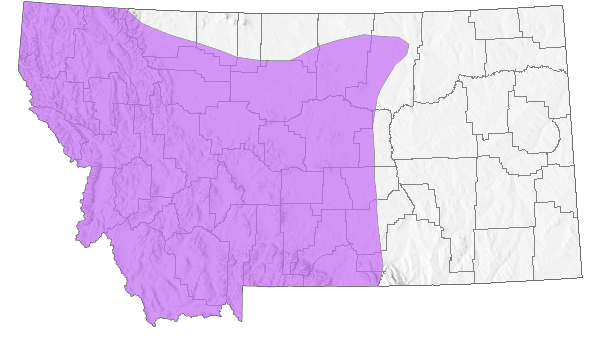
 Native
Native
Western Hemisphere Range
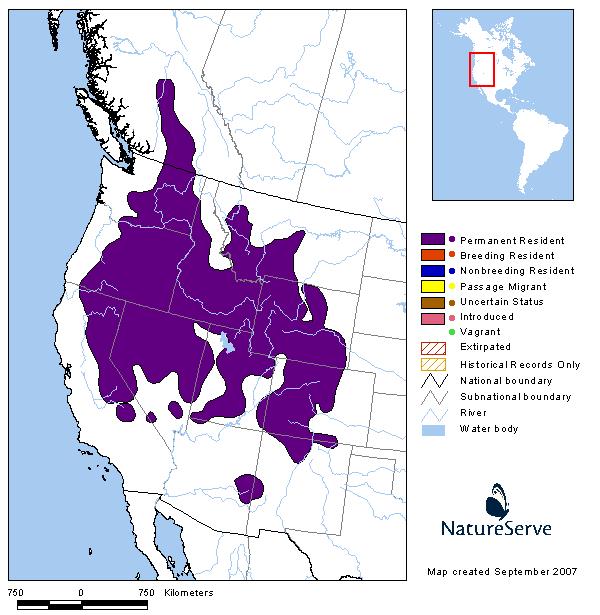
Observations in Montana Natural Heritage Program Database
Number of Observations: 503
(Click on the following maps and charts to see full sized version)
Map Help and Descriptions
Relative Density
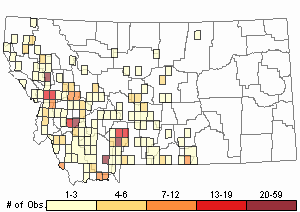
Recency

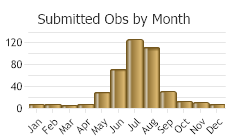
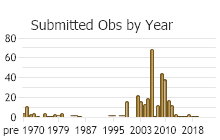
 (Observations spanning multiple months or years are excluded from time charts)
(Observations spanning multiple months or years are excluded from time charts)
Migration
Non-migratory.
Habitat
Usually dry grassland or sagebrush-grasslands. Will use wet meadows and marshes at high elevations when M. pennsylvanicus is absent (Pattie 1967 and Hoffmann et al. 1969).
National Vegetation Classification System Groups Associated with this Species
Alpine
Alpine - Vegetated
Forest and Woodland
Deciduous Forest and Woodland
Low Elevation - Xeric Forest and Woodland
Montane - Subalpine Forest and Woodland
Shrubland
Arid - Saline Shrubland
Foothills - Montane Shrubland
Sagebrush Shrubland
Grassland
Lowland - Prairie Grassland
Montane - Subalpine Grassland
Wetland and Riparian
Alkaline - Saline Wetlands
Alpine Riparian and Wetland
Peatland
Riparian and Wetland Forest
Riparian Shrubland
Wet Meadow and Marsh
Recently Disturbed or Modified
Harvested Forest
Insect-Killed Forest
Introduced Vegetation
Recently Burned
Human Land Use
Agriculture
Developed
Food Habits
In the Beartooths, in close association with M. richardsoni, used mostly forbs (Pattie 1967).
Ecology
Estimated 1.0 to 3.4/acre in the Beartooths, mean adjacent range length of 236 ft. (Pattie 1967). Population fluctuates. Can be an agricultural pest (Banfield 1974).
Reproductive Characteristics
Begins breeding in early June (Beartooths). Adults average 6.8 young/litter, subadults 5.0 young/litter. Some young females born in spring breed as subadults; some males sexually mature in August (Pattie 1967).
Stewardship Responsibility
References
- Literature Cited AboveLegend:
 View Online Publication
View Online Publication Banfield, A.W.F. 1974. The mammals of Canada. University of Toronto Press for National Museum of Natural Science and the National Museums of Canada, 438 pp.
Banfield, A.W.F. 1974. The mammals of Canada. University of Toronto Press for National Museum of Natural Science and the National Museums of Canada, 438 pp. Foresman, K.R. 2012. Mammals of Montana. Second edition. Mountain Press Publishing, Missoula, Montana. 429 pp.
Foresman, K.R. 2012. Mammals of Montana. Second edition. Mountain Press Publishing, Missoula, Montana. 429 pp. Pattie, D.L. 1967. Dynamics of alpine small mammal populations. Ph.D dissertation. University of Montana, Missoula. 102 pp.
Pattie, D.L. 1967. Dynamics of alpine small mammal populations. Ph.D dissertation. University of Montana, Missoula. 102 pp. Zeveloff, S.I. and F.R. Collett. 1988. Mammals of the Intermountain west. University of Utah Press, Salt Lake City, Utah.
Zeveloff, S.I. and F.R. Collett. 1988. Mammals of the Intermountain west. University of Utah Press, Salt Lake City, Utah.
- Additional ReferencesLegend:
 View Online Publication
View Online Publication
Do you know of a citation we're missing? [WWPC] Washington Water Power Company. 1995. 1994 wildlife report Noxon Rapids and Cabinet Gorge Reservoirs. Washington Water Power Company. Spokane, WA.
[WWPC] Washington Water Power Company. 1995. 1994 wildlife report Noxon Rapids and Cabinet Gorge Reservoirs. Washington Water Power Company. Spokane, WA. Allen, K.L., T. Weaver, and D. Flath. 1994. Small mammals in Northern Rocky Mountain ecosystems. Unpubl. report to Bureau of Land Management and United States Forest Service, August 31, 1994. Montana State Univ., Bozeman. 54 pp.
Allen, K.L., T. Weaver, and D. Flath. 1994. Small mammals in Northern Rocky Mountain ecosystems. Unpubl. report to Bureau of Land Management and United States Forest Service, August 31, 1994. Montana State Univ., Bozeman. 54 pp. Anderson, S. 1959. Distribution, variation, and relationships of the montane vole (Microtus montanus). 97 pp.
Anderson, S. 1959. Distribution, variation, and relationships of the montane vole (Microtus montanus). 97 pp. Bachen, D.A. 2014. Cheatgrass invasion of sagebrush steppe: Impacts of vegetation structure on small mammals. M.Sc. Thesis. Bozeman, Montana: Montana State University. 96 p.
Bachen, D.A. 2014. Cheatgrass invasion of sagebrush steppe: Impacts of vegetation structure on small mammals. M.Sc. Thesis. Bozeman, Montana: Montana State University. 96 p. Belk, M. C., Smith, H. D., and J. Lawson. 1988. Use and partitioning of montane habitat by small mammals. J. Mammal. 69(4):688-695.
Belk, M. C., Smith, H. D., and J. Lawson. 1988. Use and partitioning of montane habitat by small mammals. J. Mammal. 69(4):688-695. Butts, T.W., Western Technology and R.L. Eng. 1993. Continental Lime Indian Creek Mine, Townsend, MT. Life of Mine Wildlife Reconnaissance. In Life-of-Mine Amendment. Continental Lime, Inc., Indian Creek Mine & Plant. Vol. 2. October 13, 1992.
Butts, T.W., Western Technology and R.L. Eng. 1993. Continental Lime Indian Creek Mine, Townsend, MT. Life of Mine Wildlife Reconnaissance. In Life-of-Mine Amendment. Continental Lime, Inc., Indian Creek Mine & Plant. Vol. 2. October 13, 1992. Carlsen, T. 1980. Small mammal trapping in the Elkhorns. [Unpublished report]. 7 pp.
Carlsen, T. 1980. Small mammal trapping in the Elkhorns. [Unpublished report]. 7 pp. Carlsen, T. and R. Northrup. 1992. Canyon Ferry Wildlife Management Area Final Draft Management Plan. March 1992.
Carlsen, T. and R. Northrup. 1992. Canyon Ferry Wildlife Management Area Final Draft Management Plan. March 1992. Clark, S.G. and M.R. Stromberg. 1987. Mammals in Wyoming. University of Kansas Museum of Natural History, Public Education Series Number 10. xii + 314 pp.
Clark, S.G. and M.R. Stromberg. 1987. Mammals in Wyoming. University of Kansas Museum of Natural History, Public Education Series Number 10. xii + 314 pp. Craighead, A.C. 2000. Pellet and scat analysis as indicators of present and past habitats. M.Sc. Theses. Bozeman, MT: Montana State University. 219 p.
Craighead, A.C. 2000. Pellet and scat analysis as indicators of present and past habitats. M.Sc. Theses. Bozeman, MT: Montana State University. 219 p. Davis, W.B. 1937. Some mammals from western Montana and eastern Idaho. The Murrelet 18(2): 22-27.
Davis, W.B. 1937. Some mammals from western Montana and eastern Idaho. The Murrelet 18(2): 22-27. Douglass, R.J. 1973. Spatial interactions and microhabitat selections of two locally sympatric voles, Microtus montanus and Microtus pennsylvanicus. Ph.D. Dissertation. Bozeman, Montana: Montana State University. 48 p.
Douglass, R.J. 1973. Spatial interactions and microhabitat selections of two locally sympatric voles, Microtus montanus and Microtus pennsylvanicus. Ph.D. Dissertation. Bozeman, Montana: Montana State University. 48 p. Douglass, R.J. 1976. Spatial interactions and microhabitat selections of two locally sympatric voles, Microtus montanus and Microtus pennsylvanicus. Ecology 57: 346-352.
Douglass, R.J. 1976. Spatial interactions and microhabitat selections of two locally sympatric voles, Microtus montanus and Microtus pennsylvanicus. Ecology 57: 346-352. Eng, R.L. 1976. Wildlife Baseline Study [for West Fork of the Stillwater and Picket Pin drainages]
Eng, R.L. 1976. Wildlife Baseline Study [for West Fork of the Stillwater and Picket Pin drainages] Feigley, H.P. 1981. Studies on native small mammals as intermediate hosts of Echinococcus multilocularis. M.Sc. Thesis. Bozeman, Montana: Montana State University. 50 p.
Feigley, H.P. 1981. Studies on native small mammals as intermediate hosts of Echinococcus multilocularis. M.Sc. Thesis. Bozeman, Montana: Montana State University. 50 p. Feldhamer, G.A. 1979. Vegetative and edaphic features affecting the abundance and distribution of small mammals in southeast Oregon. Great Basin Nat. 39:207-218.
Feldhamer, G.A. 1979. Vegetative and edaphic features affecting the abundance and distribution of small mammals in southeast Oregon. Great Basin Nat. 39:207-218. Findley, J. S. 1951. Habitat preferences of four species of Microtus in Jackson Hole, Wyoming. J. Mammal. 32(1):118-120.
Findley, J. S. 1951. Habitat preferences of four species of Microtus in Jackson Hole, Wyoming. J. Mammal. 32(1):118-120. Foresman, K.R. 2001. The wild mammals of Montana. American Society of Mammalogists, Special Publication Number 12. Lawrence, KS. 278 pp.
Foresman, K.R. 2001. The wild mammals of Montana. American Society of Mammalogists, Special Publication Number 12. Lawrence, KS. 278 pp. Genter, D.L. 1986. Habitat selection and behavioral interactions of two sympatric voles, Microtus montanus and Microtus pennsylvanicus. M.A. thesis. University of Montana, Missoula. 49 pp.
Genter, D.L. 1986. Habitat selection and behavioral interactions of two sympatric voles, Microtus montanus and Microtus pennsylvanicus. M.A. thesis. University of Montana, Missoula. 49 pp. Haglund, B.M. 1972. Ecological effects of weather modification, Bangtail Ridge, Bridger Range, Montana: relationships of pocket gophers (Thomomys talpoides) to time of snow melt. M.Sc. Thesis. Bozeman, Montana: Montana State University. 26 p.
Haglund, B.M. 1972. Ecological effects of weather modification, Bangtail Ridge, Bridger Range, Montana: relationships of pocket gophers (Thomomys talpoides) to time of snow melt. M.Sc. Thesis. Bozeman, Montana: Montana State University. 26 p. Haight, C.P. 1937. Some observations on the predator-prey complex in the Gallatin Valley. M.Sc. Thesis. Bozeman, Montana: Montana State University. 58 p.
Haight, C.P. 1937. Some observations on the predator-prey complex in the Gallatin Valley. M.Sc. Thesis. Bozeman, Montana: Montana State University. 58 p. Hanauska-Brown, L., B.A. Maxell, A. Petersen, and S. Story. 2014. Diversity Monitoring in Montana 2008-2010 Final Report. Montana Fish, Wildlife & Parks. Helena, MT. 78 pp.
Hanauska-Brown, L., B.A. Maxell, A. Petersen, and S. Story. 2014. Diversity Monitoring in Montana 2008-2010 Final Report. Montana Fish, Wildlife & Parks. Helena, MT. 78 pp. Hayward, G. D. and P. H. Hayward. 1995. Relative abundance and habitat associations of small mammals in the Chamberlain Basin, central Idaho. Northwest Sci. 69(2): 114-125.
Hayward, G. D. and P. H. Hayward. 1995. Relative abundance and habitat associations of small mammals in the Chamberlain Basin, central Idaho. Northwest Sci. 69(2): 114-125. Heath, M.L. 1973. Small mammal populations in clearcuts of various ages in south central Montana. M.Sc. Thesis. Bozeman, Montana: Montana State University. 33 p.
Heath, M.L. 1973. Small mammal populations in clearcuts of various ages in south central Montana. M.Sc. Thesis. Bozeman, Montana: Montana State University. 33 p. Hendricks, P. and M. Roedel. 2001. A faunal survey of the Centennial Valley Sandhills, Beaverhead County, Montana. Report to the U.S. Bureau of Land Management and U.S. Fish and Wildlife Service. Montana Natural Heritage Program, Helena, MT. 44 p.
Hendricks, P. and M. Roedel. 2001. A faunal survey of the Centennial Valley Sandhills, Beaverhead County, Montana. Report to the U.S. Bureau of Land Management and U.S. Fish and Wildlife Service. Montana Natural Heritage Program, Helena, MT. 44 p. Hodgeson, J.R. 1972. Local distribution of Microtus montanus and Microtus pennsylvanicus in southwestern Montana. J. Mammal. 53(3): 487-499.
Hodgeson, J.R. 1972. Local distribution of Microtus montanus and Microtus pennsylvanicus in southwestern Montana. J. Mammal. 53(3): 487-499. Hodgson, J. R. 1972. Local distribulion of Microtus montanus and M. pennsylvanicus in southwestern Montana. J. Mammal. 53:487-499.
Hodgson, J. R. 1972. Local distribulion of Microtus montanus and M. pennsylvanicus in southwestern Montana. J. Mammal. 53:487-499. Hodgson, J.R. 1970. Ecological distribution of Microtus montanus and Microtus pennsylvanicus in an area of geographic sympatry in southwestern Montana. Ph.D. Dissertation. Bozeman, Montana: Montana State University. 65 p.
Hodgson, J.R. 1970. Ecological distribution of Microtus montanus and Microtus pennsylvanicus in an area of geographic sympatry in southwestern Montana. Ph.D. Dissertation. Bozeman, Montana: Montana State University. 65 p. Hoffmann, R.S. and D.L. Pattie. 1968. A guide to Montana mammals: identification, habitat, distribution, and abundance. Missoula, MT: University of Montana. 133 p.
Hoffmann, R.S. and D.L. Pattie. 1968. A guide to Montana mammals: identification, habitat, distribution, and abundance. Missoula, MT: University of Montana. 133 p. Hoffmann, R.S., P.L. Wright, and F.E. Newby. 1969. The distribution of some mammals in Montana. I. Mammals other than bats. Journal of Mammalogy 50(3): 579-604.
Hoffmann, R.S., P.L. Wright, and F.E. Newby. 1969. The distribution of some mammals in Montana. I. Mammals other than bats. Journal of Mammalogy 50(3): 579-604. Johnson, L.J. 1960. Mammal studies on the Lubrecht Forest, Montana: a preliminary report. Proc. Mont. Acad. Sci. 20: 40-47.
Johnson, L.J. 1960. Mammal studies on the Lubrecht Forest, Montana: a preliminary report. Proc. Mont. Acad. Sci. 20: 40-47. Joslin, Gayle, and Heidi B. Youmans. 1999. Effects of recreation on Rocky Mountain wildlife: a review for Montana. [Montana]: Montana Chapter of the Wildlife Society.
Joslin, Gayle, and Heidi B. Youmans. 1999. Effects of recreation on Rocky Mountain wildlife: a review for Montana. [Montana]: Montana Chapter of the Wildlife Society. Kinsella, J. M. 1966. Helminths of Microtinae in western Montana. M.A. thesis. University of Montana, Missoula. 61 pp.
Kinsella, J. M. 1966. Helminths of Microtinae in western Montana. M.A. thesis. University of Montana, Missoula. 61 pp. Klaus, M. 1997. Dispersal of Microtus richardsoni in the Beartooth Mountains of Montana and Wyoming. Ph.D. Dissertation. Bozeman, MT: Montana State University. 56 p.
Klaus, M. 1997. Dispersal of Microtus richardsoni in the Beartooth Mountains of Montana and Wyoming. Ph.D. Dissertation. Bozeman, MT: Montana State University. 56 p. Koplin, J.R. 1962. Competition and niche segregation in the genus Microtus. M.S. thesis. Montana State University. 66 pp.
Koplin, J.R. 1962. Competition and niche segregation in the genus Microtus. M.S. thesis. Montana State University. 66 pp. Kritzman, E.B. 1977. Little mammals of the Pacific Northwest. Pacific Search Press, Seattle, WA.
Kritzman, E.B. 1977. Little mammals of the Pacific Northwest. Pacific Search Press, Seattle, WA. McCaughey, W.W. 1990. Biotic and microsite factors affecting Pinus albicaulis establishment and survival. Ph.D. Dissertation. Bozeman, MT: Montana State University. 78 p.
McCaughey, W.W. 1990. Biotic and microsite factors affecting Pinus albicaulis establishment and survival. Ph.D. Dissertation. Bozeman, MT: Montana State University. 78 p. Medin, D. E. and W. P. Clary. 1991. Small mammals of a beaver pond ecosystem and adjacent riparian habitat in Idaho. USDA, Forest Service, Res. Paper INT-445.
Medin, D. E. and W. P. Clary. 1991. Small mammals of a beaver pond ecosystem and adjacent riparian habitat in Idaho. USDA, Forest Service, Res. Paper INT-445. Murie, J. O. 1963. Investigations of Habitat Segregation in Microtus in Western Montana. M.S. Thesis. University of Montana, Missoula. 81 Pp.
Murie, J. O. 1963. Investigations of Habitat Segregation in Microtus in Western Montana. M.S. Thesis. University of Montana, Missoula. 81 Pp. Murie, J. O. 1971. Behavioral relationship between two sympatric voles: Relevance to habitat segregation. J. Mammal. 52(1):181-186.
Murie, J. O. 1971. Behavioral relationship between two sympatric voles: Relevance to habitat segregation. J. Mammal. 52(1):181-186. Oechsli, L.M. 2000. Ex-urban development in the Rocky Mountain West: consequences for native vegetation, wildlife diversity, and land-use planning in Big Sky, Montana. M.Sc. Thesis. Montana State University, Bozeman. 73 p.
Oechsli, L.M. 2000. Ex-urban development in the Rocky Mountain West: consequences for native vegetation, wildlife diversity, and land-use planning in Big Sky, Montana. M.Sc. Thesis. Montana State University, Bozeman. 73 p. Pattie, D.L. and N.A. M. Verbeek. 1967. Alpine mammals of the Beartooth Plateau. Northwest Science 41(3): 110-117.
Pattie, D.L. and N.A. M. Verbeek. 1967. Alpine mammals of the Beartooth Plateau. Northwest Science 41(3): 110-117. Pearson, Dean E., et al., ???, Small mammal community composition, relative abundance, and habitat selection in native bunchgrass of the Northern Rocky Mountains: implications for exotic plant invasions
Pearson, Dean E., et al., ???, Small mammal community composition, relative abundance, and habitat selection in native bunchgrass of the Northern Rocky Mountains: implications for exotic plant invasions Pinter, A. J. 1986. Population dynamics and litter size of the montane vole, Microtus montanus. Canadian Journal of Zoology 64:1487- 1490.
Pinter, A. J. 1986. Population dynamics and litter size of the montane vole, Microtus montanus. Canadian Journal of Zoology 64:1487- 1490. Purdue, J.R. 1984. Note on the distribution of some mammals in the Pryor Mountains, Carbon County, Montana. Proc. Mont. Acad. Sci. 44:21-24.
Purdue, J.R. 1984. Note on the distribution of some mammals in the Pryor Mountains, Carbon County, Montana. Proc. Mont. Acad. Sci. 44:21-24. Reichel, J.D. 1996. Northern bog lemming survey: 1995: Garnet Resource Area. Montana Natural Heritage Program. Helena, MT. 35 pp.
Reichel, J.D. 1996. Northern bog lemming survey: 1995: Garnet Resource Area. Montana Natural Heritage Program. Helena, MT. 35 pp. Reid, F. 2006. Peterson Field Guide to Mammals of North America, 4th Edition. Houghton Mifflin Company: Boston and New York, 608 pp.
Reid, F. 2006. Peterson Field Guide to Mammals of North America, 4th Edition. Houghton Mifflin Company: Boston and New York, 608 pp. Rowsemitt, C. N., C. J. Welch, M. C. Kuehl, R. E. Moore and L. L. Jackson. 1988. Hormonal regulation in preputial gland function in male Microtus montanus, the Montana vole. Comp. Biochem. Physiol. 90A: 195-200.
Rowsemitt, C. N., C. J. Welch, M. C. Kuehl, R. E. Moore and L. L. Jackson. 1988. Hormonal regulation in preputial gland function in male Microtus montanus, the Montana vole. Comp. Biochem. Physiol. 90A: 195-200. Runge, Jonathan P. 2005. Spatial population dynamics of Microtus in grazed and ungrazed grasslands. PhD Dissertation. University of Montana. Missoula, MT.
Runge, Jonathan P. 2005. Spatial population dynamics of Microtus in grazed and ungrazed grasslands. PhD Dissertation. University of Montana. Missoula, MT. Rust, H. J. 1946. Mammals of northern Idaho. J. Mammal. 27(4): 308-327.
Rust, H. J. 1946. Mammals of northern Idaho. J. Mammal. 27(4): 308-327. Sera, W. E. and C. N. Early. 2003. Microtus montanus. American Society of Mammalogists, Lawrence, KS. Mammalian Species No. 716:1-10.
Sera, W. E. and C. N. Early. 2003. Microtus montanus. American Society of Mammalogists, Lawrence, KS. Mammalian Species No. 716:1-10. Stoecker, R.E. 1967. A population study of five species of small rodents in the Bridger Mountains of Montana. M.Sc. Thesis. Bozeman, Montana: Montana State University. 32 p.
Stoecker, R.E. 1967. A population study of five species of small rodents in the Bridger Mountains of Montana. M.Sc. Thesis. Bozeman, Montana: Montana State University. 32 p. Thompson, L.S. 1982. Distribution of Montana amphibians, reptiles, and mammals. Bozeman: Montana Audubon Council. 24 pp.
Thompson, L.S. 1982. Distribution of Montana amphibians, reptiles, and mammals. Bozeman: Montana Audubon Council. 24 pp. Thompson, Richard W., Western Resource Dev. Corp., Boulder, CO., 1996, Wildlife baseline report for the Montana [Montanore] Project, Lincoln and Sanders counties, Montana. In Application for a Hard Rock Operating Permit and Proposed Plan of Operation, Montanore Project, Lincoln and Sanders Counties, Montana. Vol. 5. Stroiazzo, John. Noranda Minerals Corp., Libby, MT. Revised September 1996.
Thompson, Richard W., Western Resource Dev. Corp., Boulder, CO., 1996, Wildlife baseline report for the Montana [Montanore] Project, Lincoln and Sanders counties, Montana. In Application for a Hard Rock Operating Permit and Proposed Plan of Operation, Montanore Project, Lincoln and Sanders Counties, Montana. Vol. 5. Stroiazzo, John. Noranda Minerals Corp., Libby, MT. Revised September 1996. Von Gunten. 1978. Pronghorn fawn mortality on the National Bison Range. M.S. thesis. University of Montana, Missoula. 82 pp.
Von Gunten. 1978. Pronghorn fawn mortality on the National Bison Range. M.S. thesis. University of Montana, Missoula. 82 pp. Welsh, C. J. 1985. Species-typical lipids from the body surface and preputial glands of the sympatric voles Microtus montanus and M. pennsylvanicus: characterization and identification. Ph.D. thesis, Montana State University, Bozeman. 83 pp.
Welsh, C. J. 1985. Species-typical lipids from the body surface and preputial glands of the sympatric voles Microtus montanus and M. pennsylvanicus: characterization and identification. Ph.D. thesis, Montana State University, Bozeman. 83 pp. Welsh, C. J., R. E. Moore, R. J. Bartelt and L. L. Jackson. 1988. Novel, species-typical esters from preputial glands of sympatric voles, Microtus montana and M. pennsylvanicus. J. Chem. Ecology 14:143-157.
Welsh, C. J., R. E. Moore, R. J. Bartelt and L. L. Jackson. 1988. Novel, species-typical esters from preputial glands of sympatric voles, Microtus montana and M. pennsylvanicus. J. Chem. Ecology 14:143-157. Williams, O. 1955. Distribution of mice and shrews in a Colorado montane forest. J. Mammal. 36(2): 221-231.
Williams, O. 1955. Distribution of mice and shrews in a Colorado montane forest. J. Mammal. 36(2): 221-231. Wood, M.A. 1981. Small mammal communities after two recent fires in Yellowstone National Park. M.Sc. Thesis. Bozeman, Montana: Montana State University. 58 p.
Wood, M.A. 1981. Small mammal communities after two recent fires in Yellowstone National Park. M.Sc. Thesis. Bozeman, Montana: Montana State University. 58 p.
- Web Search Engines for Articles on "Montane Vole"
- Additional Sources of Information Related to "Mammals"





